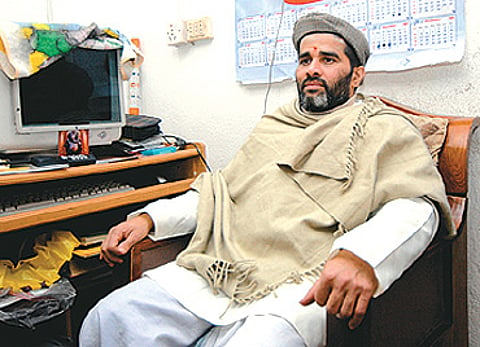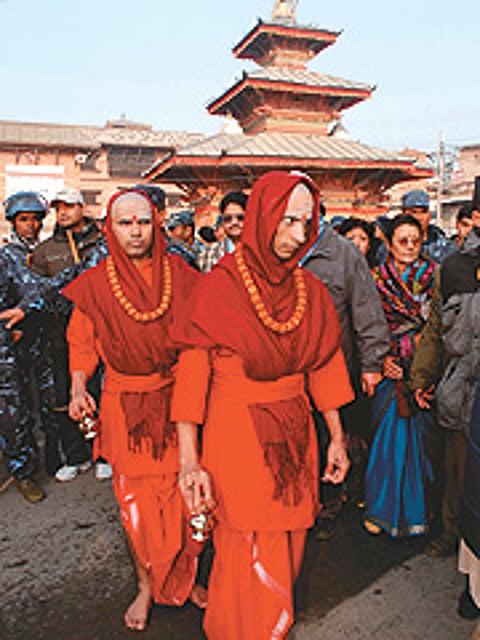Import Duty
Nepal's Maoists can snap the sacred threads bonding Pashupatinath temple and its Indian priests
- The Pashupatinath temple, whose origins date to the 5th century, is considered one of the holiest Shiva temples
- A World Heritage site, the pagoda-style temple has a golden roof, silver doors, with a five-faced Shivalinga in its sanctum, symbolising Shiva as Lord of all Living Beings
- The temple's head priests and his assistants have been recruited from south India, mainly from Karnataka's Sringeri Math, for at least 700 years
- Nepal's Maoist-led government wants to end the tradition, have Nepalese priests
***

However, over the past few weeks, it looked as if a tradition that predated modern boundary-making and its attendant nationalist tensions was being brought to a ruthlessly decisive end by Nepal's seven-month-old Maoist-led government. Resignations, believed to have been secured through political pressure, of Pashupatinath's mool bhatta (head priest) and two other bhattas— all hailing from Karnataka—were accepted by the government, which summarily installed in their place two Nepali priests (one said to be a Maoist sympathiser) not known for their familiarity with the temple's complex rituals. The new appointments bypassed the processes of vetting, and ceremonies of training, initiation and ritualistic handover that have governed succession at the shrine.
As protests erupted—from rajbhandaris, the local junior priests who assist the bhattas, from political parties within and outside the coalition, and even deposed King Gyanendra, who broke his silence to deplore the politicisation of the shrine's affairs—the Maoists initially made as if to brazen it out through the controversy. Indeed, their stormtroopers defied a Supreme Court interim stay on the government's moves by breaking locks and forcing the appointment of the new priests. To legitimise this, party cadres ratcheted up ultra-nationalist rhetoric, with its inevitable anti-India overtones, labelling the bhattas as 'foreigners', and playing up allegations of corruption in the shrine's management.
But as rifts in the ruling coalition deepened, as different stripes of Indian opinion came to be expressed, as the opposition Nepali Congress came out on the streets, and as criticism sharpened at the defiance of the court order, the government rolled back—partially—on Wednesday night. It annulled the summary new appointments and brought back the bhattas to perform pujas until the "next arrangement". But it made it clear that their resignations were accepted, paving the way for their eventual departure. While the government promised to comply with legal and traditional procedures in choosing their successors, what prime minister Prachanda left unclear was whether these successors would be Nepalese or Indian citizens.
Despite the lack of clarity, some feel that the days of priests travelling here from South India to take up their jobs at the temple may well be over. "It is hard to imagine," says commentator Kanak Mani Dixit, who views the government's latest moves as an interim measure to show respect for the Supreme Court, "that an Indian citizen would be appointed once this episode reaches its conclusion." Dixit believes that if the Maoist government shows some sensitivity for procedure and norms, instead of riding roughshod over them, as it did in its attempt to 'capture' a symbol of national prestige, it may well get away with not appointing Indians as bhattas.
In the debates raging last week around the government's actions, two issues got intertwined—one, the fate of Indian priests, and two, the violation of norms and procedures, whether religious or legal-constitutional, by a ham-handed government meddling in matters of faith. But what did come through, in the voices and arguments, is that of the two, it was the latter that was really top of the mind.

Newly appointed Nepali priests Bishnu Dahal & Saligram Dhakal |
As Nepalese devotees lined up for worship at the Pashupatinath Temple earlier this week, there was not a person among the scores I spoke to who did not express outrage at the disruption of the nitya puja during the turbulence at the shrine (the story goes that it was not stopped even when Turks looted the shrine), at the skipping of sacred rites of worship, such as the bathing of the linga, and of ritual offerings to it by sarkari priests who did not know them. Many strongly communicated a sense that the shrine had been desecrated by these omissions. But few argued that the ancient tradition of Indian priests presiding over the shrine should be maintained at all costs; or that 'desh' and 'videsh' were not relevant terms in matters of faith.
On the contrary, many conversations, even with those who condemned the government's action, suggested that the terms "Indian" and "Nepalese" had been internalised, and were now being freely used to describe a priestly order that had not earlier been perceived in terms of nationality. "What the government did was wrong," said Tikaram Pokhare, a devotee at the shrine. It was done without consultation, he pointed out, adding that priests should be chosen by rules and regulations, through competition. But he added, "Nepal ke aadmi Nepal ke bhagwan ki puja karein to achha rahega (It would be nice if men from Nepal worshipped the gods of Nepal)." Many also pointed out that for far too long, the financial affairs of the Pashupatinath Temple had been murky, thanks to the tight nexus between the monarchy and the bhattas, and it was time for reform and transparency at the temple.
In their homes in traditional red-brick buildings adjoining the temple complex, the bhattas also reflected on the turbulent goings-on. Wearing veshtis with traditional South Indian borders and speaking fluent but accented Nepali, they seemed both at home, and abroad, in Nepal. Shriram Bhatt, one of the five bhattas at the shrine, explained, interestingly, that until 60 years back, in times when travel was far more difficult, the bhattas who came here (from south Maharashtra, Andhra Pradesh, Tamil Nadu and Karnataka) settled in Nepal in a more integrated sense, marrying their children to locals. But with growing ease of travel, they have increasingly gone back to their native places once their jobs have been done. Hardly stepping out of their narrow rooms—festooned with calendars covered with religious kitsch—as the government's priests officiated at the shrine, the nervous bhattas were clearly worried for their own security, and some seemed eager to go home. The unexpectedly youthful-looking mool bhatta, bespectacled 42-year-old Mahabaleshwara Bairy, who studied at Karnataka's Sringeri Math, and briefly taught students at a religious institution on the outskirts of Noida before coming to Nepal at the age of 25, was the most reluctant to meet or speak, not venturing beyond small talk and biographical information. (He refused to be photographed.) When I asked him about his future plans, he asked in return: "Brahmin ka aur kya kaam hota hai, adhyatmik chintan ke siva (what else can a Brahmin do but pursue spiritual matters)?"
Other bhattas spoke compellingly and insistently about the impurity of the rituals being performed at the shrine in their absence. In almost overwhelmingly copious detail, they described the daily ritual bathing, ornamentation and feeding of the deity, and various special Vedic and tantric rituals performed, evoking a world where every tiny gesture was invested with enormous significance. In equally minute detail, they described selection processes before their journeys to Nepal, involving recommendations by various Shankaracharyas, vetting by royal priests in Nepal and three days of training in seclusion, before being taken to the shrine. Against this backdrop, it was not surprising that they were back in the shrine as soon as the government allowed it, performing a kshama puja (apology puja) for the disruption of worship. But it was clear from the tenor of their melancholy conversations that they felt they were witnessing the passing of an era.
Tags